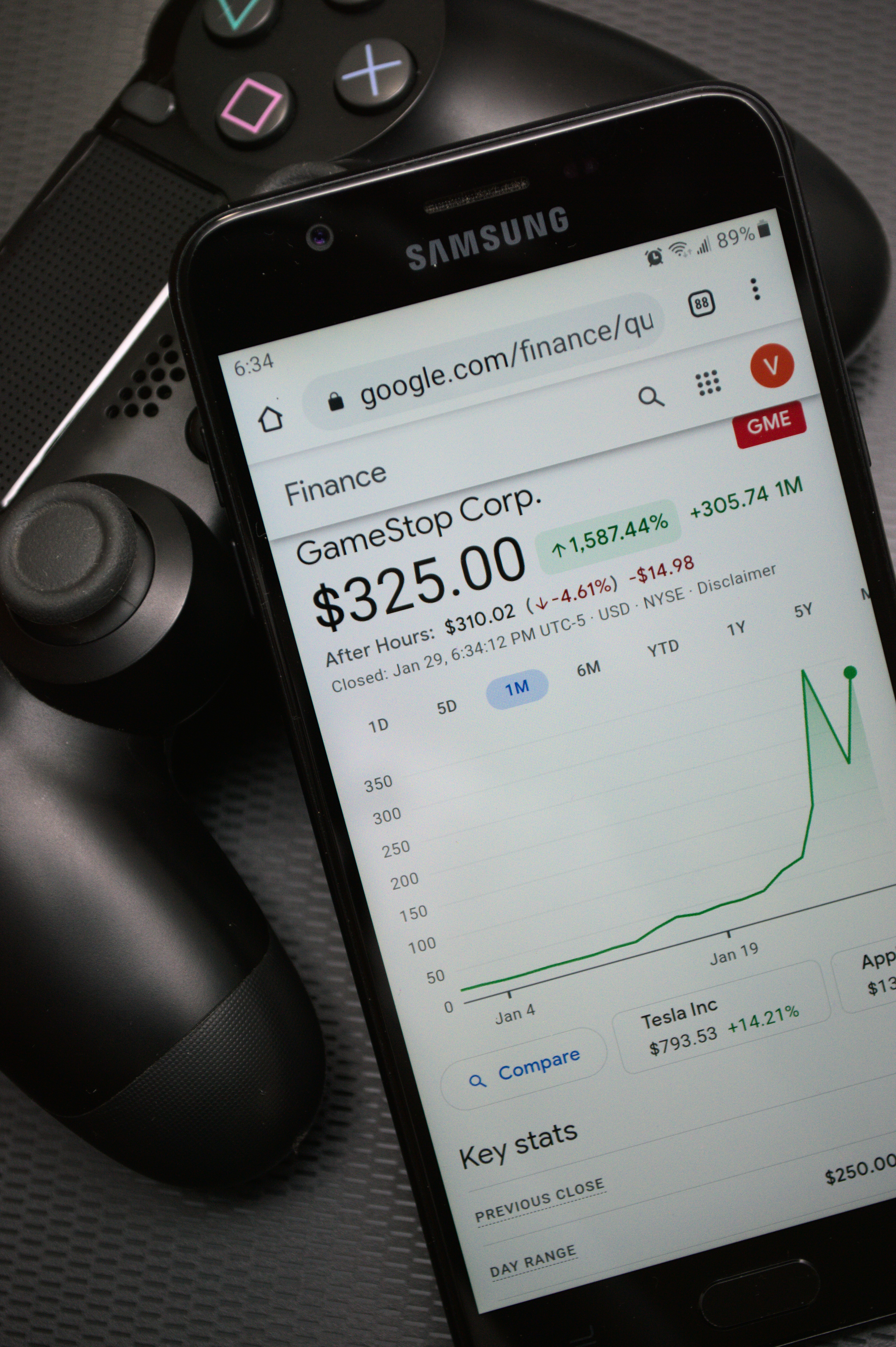Finance
Make Money with Crypto: The Scariest Thing About Crypto

Make Money with Crypto: The Scariest Thing About Crypto
The scariest thing about crypto is the price tag. Seeing cryptos that cost thousands of dollars can be intimidating, especially when you need to put down four or five figures to buy one ETH or one BTC. Now, many seem to think you need a lot to make a lot. However, this couldn’t be further from the truth. You can invest in crypto with as little as a few dollars, and you can still make massive amounts of money if you invest a small allocation strategically. Of course, this is easier said than done. That’s why today we’re going to give you a step-by-step guide about how to make money with crypto if you’re on a budget and how you can turn a few bucks into billions. My name is Guy, and this is The Coin Bureau. I’ll start by saying that nothing in this video is financial or investment advice; it’s purely educational crypto content that’s meant to help you on your crypto co-quest. If you are looking for financial or investment advice, please contact a licensed financial adviser in your area who knows about crypto.
Make Money with Crypto by Understanding Your Number One Enemy: Fees
The first step to make money with crypto on a budget is to understand Make Money with Crypto your number one enemy: fees on cryptocurrency exchanges. Depending on the exchange and the amount, it can cost as much as 10% of your initial investment just to buy the crypto you want. That means you’re immediately at a loss. More importantly, if you plan on trading crypto on exchanges, then you should know that those trading fees can add up too. Not only that, but some crypto exchanges have surprisingly high minimum trades on the spot market, never mind the enormous funding fees that you often pay when trading on margin. If that wasn’t bad enough, most exchanges also charge an arm and a leg to withdraw your crypto to your personal wallet. Depending on the blockchain you’re using and how busy the network is, it can literally cost you up to $50 just to withdraw your crypto, never mind the fees for withdrawing your fiat. Thankfully, there’s an easy way to reduce these fees and even get extra money for buying and trading your favorite coins and tokens: The Coin Bureau Deals Page. It offers trading fee discounts of up to 60% on the best crypto exchanges along with sign-up bonuses of up to $40,000. Now, unfortunately, the Coin Bureau Deals Page can’t help you with the sizable withdrawal fees that these exchanges sometimes charge. Fortunately, though, it can help you get a discount on some of the best hardware wallets in the industry — wallets that will keep your coins and tokens safe while you accumulate. These are exclusive deals that we’ve managed to negotiate on behalf of our viewers. If you want to take advantage of them while they’re still around, use the link in the description.
Make Money with Crypto by Choosing the Right Crypto Exchange or Platform
This ties into the second step to make money with crypto on a budget, which is to choose the crypto exchange or platform that’s right for you. This is something that most people don’t think about when they get into crypto. They just go with a name they recognize and then make it their only option. Before you create an account on a crypto exchange, you want to make sure that it supports the cryptos you’re interested in. One of the biggest mistakes you can make is paying fees to get your money onto an exchange only to find that it doesn’t support the crypto you want. I’m speaking from experience here. On that note, once you’ve identified the exchange that supports the cryptos you’re interested in, you want to make sure that you won’t be charged a fortune for getting your money in and out. Typically, exchanges will have this information on their website: the card fee and bank transfer fee. Just don’t forget to account for the fees that your own bank will charge you for buying crypto by card or wire transfer. You’ll be shocked at how much the banks can take sometimes. Depending on where you are in the world, you can use a virtual bank like Revolut as a middleman to reduce these fees. DYOR on that one. From what we’ve seen, the best way to get your money on and off exchanges is using fast payment systems. There are just two problems there. The first is that most crypto exchanges don’t support fast payment systems. The second is that fast payment systems are precursors to dystopian CBDCs. More about that in the description. I digress.
Make Money with Crypto by Choosing the Right Coin or Token
Another factor to keep in mind when choosing a crypto exchange is to make sure that it supports the cryptos you’re interested in on blockchains that aren’t absurdly expensive to use, like Ethereum. In all seriousness, if you’re investing on a budget, you need to watch out for these fees. Unlike fiat fees, fees for withdrawing coins and tokens on certain blockchains aren’t always noted on the websites of crypto exchanges. This is simply because these fees tend to change frequently. It also doesn’t help that many crypto exchanges don’t note which networks they support on their websites either. To be honest, the best way to check this is to make an account and check it manually yourself before buying. It never hurts to have more than one exchange account, which is why you should seriously take advantage of those offers on the Coin Bureau Deals Page. Remember, link in description.
Make Money with Crypto by Setting Realistic Expectations
This relates to the third step to make money with crypto on a budget, and that’s to choose the coin or token that’s right for you. If you’re investing on a budget because you don’t have much to invest to begin with, then you’re better off investing in established cryptos that will be around indefinitely. By contrast, if you’re investing on a budget because you’re gambling, well then, feel free to splurge on the most speculative coins and tokens you can find. If you’re having a hard time finding these coins and tokens on centralized exchanges, though, then you might be going a bit too far out on the risk curve. Besides being listed on an exchange that you can use and supported on a blockchain that won’t blow up your wallet when you withdraw, the crypto that’s right for you is one that you can understand and get on board with. This requires research, which you should always do regardless of how much you invest.
Make Money with Crypto by Taking Profit
The fifth step to make money with crypto on a budget is taking profit. As with researching cryptocurrency, we probably have over a dozen videos about how and when to take profits. As with research, there is a shortcut to taking profit as well. If you see the coin or token you bought all over the crypto news and on crypto social media like Twitter, then chances are it’s time to take profit. If you see coins or tokens you bought all over the mainstream media and on local billboards and such, then it’s probably time to cash out completely. And if your friends and family start asking you about the coin or token you bought, sell everything and run for the hills. In all seriousness, social sentiment is a surprisingly accurate indicator of when it’s time to buy and when it’s time to sell. Before you ask, yes, we have a video about sentiment trading too. The tricky thing about sentiment trading is that you can often get caught up in the narrative and start believing that your 10x will turn into a 100x. One way to protect against that is to take profits along the way so that if you do get caught up in the hype, you still have something left at the end of the day. But the best way to protect yourself against the hype is to set a target and stick to it.
Finance
The One Financial Move That Can Change Everything: Build an Emergency Fund

Why an Emergency Fund Matters
If you want to worry less about your finances, build wealth, and avoid debt, it all starts with an Build an Emergency Fund. One of the lowest financial points anyone can experience is being unable to cover an unexpected expense—like a car repair—due to lack of savings. These situations are often a result of not planning ahead or failing to budget properly.
The Reality of Financial Ups and Downs
Even in months of high earnings, Build an Emergency Fund peace of mind comes from knowing that there’s a financial cushion to fall back on during low-income periods. An emergency fund is crucial for covering unexpected expenses like a broken boiler, roof repair, or job loss. Sometimes, more than one emergency can occur at once, making financial stress even more difficult if you’re living paycheck to paycheck.
The Cost of Ignoring It: Debt Trap
Without an emergency fund, a single unexpected cost can force you into debt. Add another emergency fund on top of that, and you could fall deeper into the cycle. Paying off debt, especially with high interest rates, only makes things harder. It’s a vicious cycle that holds you back financially—but there’s a way out.
Why Emergency Funds Come Before Investments
Investing may seem more exciting, especially with social media trends encouraging immediate wealth building. But financial experts typically advise having an emergency fund before investing. Investments work best over time, and markets can have ups and downs. You don’t want to be forced to pull money out of your investments during a downturn just to cover an emergency. That’s why emergency funds are vital—they protect your investments by covering unexpected costs.
How Much Should Be in an Build an Emergency Fund?
Most financial experts recommend setting aside 3 to 6 months of essential expenses. For example, if your monthly essentials cost £2,500, you’ll want about £7,500 in your emergency fund. While that may seem like a lot, especially given that the average savings in the UK is only around $1,000, it’s important to remember that these figures vary. Nearly half of people have £1,000 or less in savings, so if you’re above that, you’re already ahead.
Adjusting Based on Your Lifestyle Build an Emergency Fund
This isn’t a one-size-fits-all approach. If your lifestyle is frugal, your car is reliable, and your housing costs are low, you might not need as large a fund. It helps to identify your own worst-case scenario—like losing your job—and base your fund size around that. Start small: aim for £1,000, then one month of expenses, and build from there.
When to Stop Contributing to the Build an Emergency Fund
There will come a point when your emergency fund is “full.” Keeping £100,000 in a low-interest savings account doesn’t make sense if you’re neglecting pensions or investments. Balance is key.
How to Build Your Emergency Fund
1. Break It Down into Steps Build an Emergency Fund
Set a target and timeframe. For example, to save £7,500 over 24 months, you’d need to save about £310 each month. If that’s not possible, start smaller but stay consistent.
2. Automate Your Savings Build an Emergency Fund
Make saving automatic. Set up a direct debit so the money goes into your emergency fund as soon as your income hits your account. Make it a non-negotiable part of your budget.
Important Note: If you have high-interest debt, like credit card debt, focus on paying that off first. No savings interest will outweigh the cost of that kind of debt.
3. Use Savings Challenges or Micro-Savings Apps
Savings challenges like the Penny Challenge or 100 Envelope Challenge can be fun ways to build savings gradually. Micro-savings apps (e.g., Plum) or banking app features that round up transactions and set the difference aside are also helpful tools to boost savings effortlessly.

Where to Keep Your Emergency Fund
Accessibility is Key Build an Emergency Fund
Your emergency fund needs to be easy to access. Avoid stashing it in accounts with withdrawal penalties or low interest. Look for an easy-access saver account that allows multiple withdrawals if needed and offers the best interest rate possible.
Consider Tiered Saving Accounts Build an Emergency Fund
If you have a larger fund—say over £5,000—you might want to split it: keep some in a very accessible account (even if interest is lower) and the rest in an account with better interest but limited withdrawals. Shop around for the best deals and be open to moving your money.
Build an Emergency Fund: The Foundation of Wealth Building
An emergency fund helps avoid debt and stress, but it’s your long-term savings, pensions, and investments that truly build wealth. Think of the emergency fund as your financial foundation. It protects your future gains and helps keep your financial goals on track.
Even if you can only invest £50 a month, over 20 years with a 6% return, you could end up with around £22,000. And it’s your emergency fund that ensures you can consistently save or invest that £50, no matter what life throws your way.
Finance
Emergency Fund Calculation: How Much Should You Really Save?

The easiest way to Emergency Fund Calculation is to not calculate at all and to rely on a couple of data points. The rule of thumb for emergencies is that you should have 3 to eight months of expenses saved away in an emergency fund. But where did we get here, and why have we been regurgitating that same advice for years? Many financial experts have repeated this advice, but it’s worth questioning its origins and whether it still applies today. For many years, we’ve heard that you need a large emergency fund, but it took some critical thinking to figure out where this information came from and whether it’s still relevant.
What Is an Emergency Fund?
An Emergency Fund Calculation is cash that you have in a savings account, preferably a high-yield savings account, that you can tap into in the event of an emergency. This is a crucial piece of financial security and stability because the idea is that if you have cash on hand and you have an emergency, you can pull that money out of the emergency fund. It prevents you from going into a deeper financial hole if you had no money in a savings account and had to rely on high-interest credit cards, personal loans, or borrowing from others.
The Purpose of an Emergency Fund Calculation
The idea is that an emergency fund provides both literal and emotional peace of mind, offering a financial safety net.
New Research on Emergency Fund Calculation Amounts
Some researchers, Jorge Saat and Emily Gallagher, have crunched the data to determine how much money people should be saving for emergencies. They found that the traditional advice of having 3 to 6 months of income set aside isn’t supported by data. Instead, they looked at lower-income individuals who are more likely to need an emergency fund and don’t have access to other resources.
What the Research Found Emergency Fund Calculation
Their research found that the amount needed to prevent an emergency from becoming a financial disaster is not as high as 3 to 6 months of expenses. In 2019, they found that $2,467 was the amount needed to prevent an emergency from turning into financial hardship. Additionally, once you hit $500 saved, each additional dollar you save increases the likelihood that you won’t fall into financial hardship in an emergency.
What This Means for You
This research gives us a more data-backed approach to saving for emergencies. Rather than aiming for 3 to 6 months of expenses, we now have a better benchmark to start with. Instead of thinking you need to save an overwhelming amount, you can aim for a more achievable starting goal.
Setting Realistic Emergency Fund Calculation Goals
In 2020, about a quarter of Americans had less than $400 available in case of an emergency. Therefore, setting a goal of $400 for your emergency fund is a good starting point. After reaching $400, you can work on building up to $1,000. This is more of a mental goal than anything rooted in data, but for many people, seeing four digits in their bank account helps them feel secure.
Inflation-Adjusted Amounts Emergency Fund Calculation
Once you’ve saved $1,000, it’s time to move toward the inflation-adjusted amount found in the research. The study was conducted in 2019, but considering inflation, the amount now is $2,970. This is a more realistic number to aim for in today’s financial landscape.
Building Your Emergency Fund Calculation in Tiers
After reaching these early benchmarks, it’s important to adjust the amount to match your personal situation. For example, if you look at your last three months of spending, you’ll get a better idea of what your real expenses are. From there, you can calculate the amount needed for a one-month emergency fund based on your essentials like rent, transportation, food, and medicine.
Calculating Your One-Month Emergency Fund Calculation
This amount could range from $3,000 to $10,000, depending on your circumstances.

Quick Reminders About Emergency Funds
Purpose and Use of Emergency Fund Calculation
A couple of quick reminders about emergencies: They are meant to be used in the event of an emergency and not for discretionary purchases like designer sales or a weekend getaway. Your emergency fund should be kept in a readily accessible place, ideally in an FDIC-insured high-yield savings account.
Where to Keep Your Emergency Fund Calculation
While checking accounts offer minimal interest, high-yield savings accounts currently offer interest rates between 4% and 5%, which means your money will grow even as you keep it accessible for emergencies. This emergency fund is not meant to be invested or used for long-term goals. It’s simply there to provide peace of mind and security in the event of a financial emergency.
Finance
Analysis of Nvidia Stock Price Chart: Trends and Insights

Introduction to Nvidia and Its Market Position
Nvidia Corporation, founded in 1993, has become a significant player in the semiconductor industry, particularly noted for its pioneering work in graphics processing units (GPUs). Originally targeting the nvidia stock price chart gaming market, Nvidia has expanded its innovations into various sectors, including artificial intelligence (AI), data centers, and automotive technology. Over the years, Nvidia has evolved from a focused graphics company to a diversified technology leader, driving advancements in parallel computing and deep learning, among other areas.
Historically, Nvidia’s stock performance has mirrored Nvidia stock price chart its substantial business achievements and technological breakthroughs. The company went public in 1999, and its stock price has seen remarkable growth, especially in the past decade. Key milestones, such as the introduction of the CUDA programming model and advancements in ray tracing technology, have solidified Nvidia’s dominance in the GPU market. The company’s strategic investments in AI technologies have further positioned it as a key resource in the evolving tech landscape, impacting sectors that range from gaming to complex scientific research.
Nvidia’s innovative trajectory is underscored by notable collaborations and acquisitions, which have expanded its capabilities and market reach. The acquisition of Mellanox Technologies in 2020, for instance, enhanced Nvidia’s data center business and allowed it to broaden its portfolio of high-performance computing solutions. This decisive move illustrates the company’s commitment to steering its growth through technology alignment and market demand. As a result, Nvidia continues to capture significant market share, resulting in impressive financial performance and positioning within the semiconductor ecosystem.
This overview sets the context for a deeper analysis of Nvidia’s stock price chart, where we will explore the trends and insights that have influenced its market valuation over the years.
Understanding the Nvidia stock price chart: Key Metrics and Indicators
The analysis of Nvidia’s stock price chart is essential for investors seeking to make informed decisions. Several key metrics and indicators can provide valuable insights. Firstly, the price-to-earnings (P/E) ratio is a critical metric. This ratio helps investors understand the valuation of Nvidia’s stock relative to its earnings. A higher P/E may indicate that the stock is overvalued, or alternatively, it may reflect strong market confidence in future growth.
Another important element is the market capitalization, which provides a comprehensive view of Nvidia’s total value as a publicly traded entity. By multiplying the current stock price by the total number of outstanding shares, market capitalization facilitates comparison with competitors and identifies Nvidia’s position within the technology sector.
Moreover, trading volume is a crucial indicator that shows the number of shares traded within a specific timeframe. Increased trading volume often signals heightened investor interest, which can impact stock price movements. For instance, abnormal spikes in trading volume may indicate that significant news has prompted a re-evaluation of the stock, making it a notable point of analysis.
In addition to fundamental metrics, technical indicators play a significant role in stock analysis. The moving averages smooth out price data over a specific period, thereby helping to identify trends. A common strategy involves observing the crossover of short-term and long-term moving averages to signal potential buy or sell opportunities.
The Relative Strength Index (RSI) is another technical indicator that measures the speed and change of price movements, typically ranging from 0 to 100. An RSI above 70 suggests that the stock may be overbought, whereas an RSI below 30 indicates it may be oversold, giving investors insight into potential entry or exit points. Lastly, the Moving Average Convergence Divergence (MACD) helps determine momentum and trend direction, offering further guidance on possible trading actions.
Historical Trends in Nvidia stock price chart: A Detailed Analysis
Nvidia Corporation, a leader in graphical processing units (GPUs) and artificial intelligence technology, has undergone significant fluctuations in its stock price since its initial public offering in 1999. Analyzing the historical trends of Nvidia’s stock reveals the influence of various factors, including product innovations, earning performance, and broader market dynamics.
In the early years, Nvidia’s stock price was relatively stable, with modest gains resulting from steady product releases aimed at both consumers and professionals. However, a notable transformation occurred in the mid-2010s when demand surged due to the rise of gaming and cryptocurrency mining. This phenomenon contributed to a sharp increase in Nvidia’s stock as the company capitalized on its industry-leading technology, leading to a peak market valuation.
Key product launches have played a critical role in shaping the stock price trajectory. The introduction of the Pascal architecture in 2016 marked a milestone, significantly enhancing performance and driving sales across various segments. Subsequent releases, like the Turing architecture, captured market attention, further propelling stock prices. Additionally, Nvidia’s strategic moves into artificial intelligence and data centers have highlighted its adaptability and potential for long-term growth, positively influencing investor sentiment.
Earnings reports have also been crucial in affecting Nvidia’s stock trends, often resulting in volatility. For instance, in Q2 2021, robust earnings and optimistic guidance led to an unprecedented spike in stock prices. Conversely, unexpected results or cautious forecasts can lead to rapid declines. Furthermore, external factors, such as shifts in market sentiment and economic conditions, have driven fluctuations, illustrating the stock’s volatility.
Overall, Nvidia’s stock history presents a compelling case study of how innovation, market trends, and external factors converge to drive performance, underscoring the importance of comprehensive analysis for investors looking to engage with this dynamic stock.
Future Outlook for Nvidia’s Stock: Analyst Predictions and Market Sentiment
The future outlook for Nvidia’s stock appears to be influenced by multiple factors, including technological advancements, competitive pressures, and macroeconomic conditions. Analysts have been bullish on Nvidia’s capacity to harness growth in areas such as artificial intelligence (AI) and gaming, which are pivotal to its growth strategy. With AI applications gaining traction across industries, Nvidia’s GPUs play a critical role, propelling expectations for expansive revenue streams. According to several analysts, this strong growth avenue could significantly bolster Nvidia’s stock price in the coming quarters.
Moreover, advancements in gaming technology, particularly with the emergence of next-generation consoles and graphics performance enhancements, position Nvidia as a leading player in this segment. The company’s commitment to innovation and its continued development of cutting-edge graphics cards could resonate positively with investors, reinforcing confidence in the stock’s potential. Analysts forecast a favorable trajectory if Nvidia maintains its competitive edge and expands its market share in the gaming industry.
However, potential challenges exist that could affect stock performance. Increased competition from companies like AMD and Intel presents a dynamic environment that may pressure Nvidia’s pricing strategies, potentially affecting margins. Additionally, the volatility surrounding semiconductor supply chains and geopolitical tensions adds a layer of uncertainty that analysts are closely monitoring. Recent headlines regarding tech regulations and trade relations can also cultivate caution among investors.
Market sentiment has shown resilience, with investors largely optimistic about Nvidia’s future proving evident from recent trading patterns. Overall, while the outlook for Nvidia’s stock remains promising with robust opportunities in AI and gaming, stakeholders should stay vigilant regarding market dynamics and competitive factors that might influence performance. As both analysts’ predictions and market sentiment evolve, a comprehensive analysis is essential for those evaluating Nvidia’s stock potential moving forward.
-

 Finance2 months ago
Finance2 months agoThe Importance of Business Card Holders: A Comprehensive Guide
-

 Finance2 months ago
Finance2 months agoUnderstanding Apple Business Manager: A Comprehensive Guide
-

 Finance2 months ago
Finance2 months agoUnderstanding the Business for Sale Market: A Comprehensive Guide
-

 Finance2 months ago
Finance2 months agoThe Evolution of Office Depot Business: A Comprehensive Overview
-

 Online Games Platform2 months ago
Online Games Platform2 months agoExploring the World of Go Game Online: A Comprehensive Guide
-

 Finance2 months ago
Finance2 months agoThe Whiskey Business: An In-Depth Exploration of a Timeless Industry
-

 Online Games Platform2 months ago
Online Games Platform2 months agoThe World’s Hardest Game: An In-Depth Analysis
-

 Tech2 months ago
Tech2 months agoTech Deck: A Comprehensive Guide

















